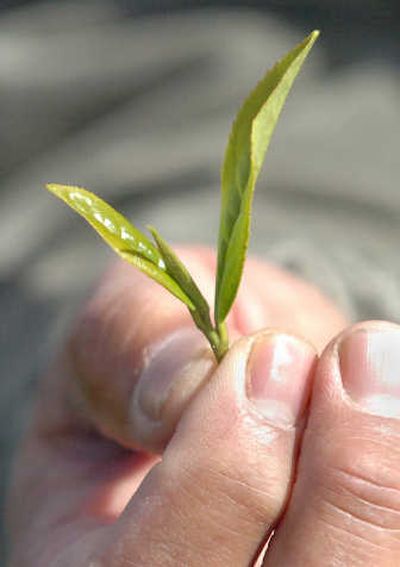The leaf has turned

BURLINGTON, Wash. – Just behind the Sakuma Brothers Farms Market Stand, in a 5-acre field bordered by a strawberry patch, a decade-long project to bring locally grown tea to market has finally come to fruition.
Earlier this summer, workers walked through the tightly packed rows of nondescript evergreen plants, named Camellia sinensis, and pinched off the plants’ leaves near the stem.
Later, the leaves were heated, rolled and dried in the sun, with the resulting brittle flakes ready to be steeped in water and served as tea.
Last month, after the Sakumas’ first sale of loose-leaf green and white teas, the family-owned farm became just the second commercial tea plantation in the continental United States, and the first on the West Coast.
Sakuma Brothers Farms, which is one of the largest berry producers in the state, began the project 10 years ago with an eye toward what the owners felt was tea’s enormous upside. Back then, discussions centered on the potential to not only establish tea as a crop, but also create what partner and third-generation farmer Richard Sakuma describes as a Napa Valley-like destination for tea, with multiple producers sharing resources and expertise.
Translating those ambitions into a single bag of tea has taken longer than expected. But with consumer demand for tea skyrocketing and interest in locally grown food doing the same, the incentive has been building for the Sakumas to get their tea out of the ground.
At a minimum, they’re hoping to find out whether tea can be a value-added crop for farmers throughout the valley.
“It’s so unique, and there’s so much potential,” Sakuma said. “The time is right, right now.”
Before tea rivals tulips as the valley’s attention-grabbing crop, Sakuma knows that they’ll first need to answer fundamental questions about yields, investment returns and market demand for domestic-grown loose-leaf tea. That’s something he figures is best done by putting it on the shelf at the farm’s market stand and seeing how consumers respond.
“It’s an alternative crop for the valley,” he said. “It’s still kind of far out there.”
Actually, tea remains a fairly obscure crop throughout the country. According to Joe Simrany, president of the New York-based Tea Association of the USA Inc., Americans consumed 2.25 billion gallons of tea last year, and nearly all of it originated in equatorial regions in South America, Asia and the Middle East.
Meanwhile, domestic tea production is limited to the approximately 30 acres grown at a Charleston, S.C.-based plantation owned by Bigelow Tea, which is billed as the only U.S. commercial tea plantation, although a collective of small growers in Hawaii started a pilot project producing and marketing tea several years ago.
Simrany said that competition from low-cost international producers is the main reason why domestic tea production remains almost nonexistent.
Tea is notorious for how much labor it takes to produce, especially good tea, he said. Given the nature of the high cost of processing tea in this country, from a labor standpoint and everything else, it’s very difficult, and it puts producers here at a competitive disadvantage.
The one way around that, Simrany said, is to produce a high-quality tea that nets a much higher price.
High-grade tea means harvesting only the two leaves and bud at the end of a branch, and forgoing the coarser leaves near the stem, a process requiring more finesse than a machine can bear.
The Sakumas purchased a harvesting machine, but so far they’ve been picking leaves by hand to extract higher-grade leaves.
The Sakumas are also working against a lingering perception that tea is a warm weather crop best-suited to equatorial regions. Based on the farm’s experience thus far, that perception doesn’t hold.
When the project began in the late 1990s, they chose plant clones originating in higher altitudes, which were more likely to thrive in the upper Puget Sound’s cool climate. They’ve now identified about four clones that grow well here.
Sakuma Brothers Farms encompasses more than 1,000 acres of berries, which are clearly the farm’s mainstay. Finding a window to harvest tea leaves, which ripen at the same time as the berries, proved impossible.
Thus, every summer for years, Richard Sakuma would remark, “Oh dear, I need to do something about that tea.”
With a little help from some of the fourth-generation family members working on the farm, the tea was finally harvested and processed this summer.
For now, the farm remains content producing green and white tea, but not black. All three come from the same plant. Processing and exposing fresh tea leaves to oxygen determines the resulting type of tea.
“It’s like winemaking,” Richard Sakuma said. “You manipulate the blends.”
After a little more than a month of modest sales of the tea from the farms Burlington market stand, Haggen grocery has already expressed an interest in stocking it.
Having raised berries in the Skagit Valley since the 1930s, the Sakumas aren’t looking to become tea moguls, but if successful, this experimental crop would be a welcome addition to their farm.
“We’ve always raised berries throughout the generations. It’s what we do,” Richard Sakuma said. “But if we can develop something and make a modest profit, it would be exciting.”